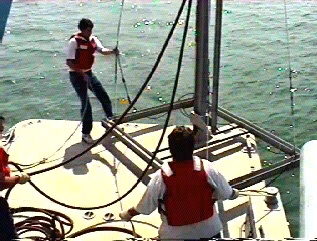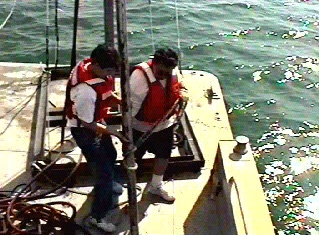A USGS Marine and Coastal Studies Skill Training Module
1D. Deploying, retrieving & preparing
The process on the right illustrates the three steps to deploy, retrieve and prepare a core sample for transport. The details are discussed in the videos and outlined below.
Process Diagram:

1. Deploying the vibracore

1D1. Deploying the vibracore - Video 1D1.
* During the deployment and retrieval, two tag lines are used to help stabilize and
position the vibracore rig when the crane is being used to move the rig.
* Before deployment the barrel must be attached to the nipple on the vibrator head.
* When the crane is used it is very important to assure everyone’s safety. Always be
aware of where the crane is overhead.
* Always use caution and avoid placing toes or fingers under the rig when it is raised
from the deck even if it is sitting on blocks. Take care to anticipate the swinging of the
rig during rough weather.
* After clamping the barrel to the nipple, the crane will raise the vibrator head. Guide
the barrel into the kick stand at the base of the "I" beam. Lower the kick stand
to the deployment position.
* Use the crane to rotate the rig into the proper position so that it will pivot out from
the deck. NOTE: Pay attention to assure that the air lines and the tag lines are clear and
not tangled. As the rig clears the boat the tag lines are dropped and the rig is lowered
to the bottom.
* When the rig reaches the bottom, the air is turned on and the vibrator begins to vibrate
the barrel into the sediment. The potentiometer is used to determine the depth of the core
into the sediment if the rig is completely submerged.
1D2. Retrieving the vibracore - Video 1D2.
* When the coring is complete the air is turned off to the vibrator.
* The crane is used to put tension on the cable to pull the core free of the sediment. The
boat may heel considerably during this operation.
* The tag lines are retrieved as the rig nears the boat. When both lines are in place, the
rig will be lifted to the deck.
* Attention must be given to assure the correct position of the rig frame on the deck to
facilitate the removal of the core barrel from the nipple.
* When the frame is on the deck a core cap is placed over the end of the barrel. The
barrel is wiped clean and duct tape is used to secure the cap to the barrel.
ATTENTION: Failure to cap and tape the barrel properly will result in the loss of the
core sample.
* After the cap is in place, a line is placed around the now very heavy barrel to help
handle it for the next operation.
* The core barrel is now lowered towards the deck and held in position with the top of the
barrel higher than the bottom end.
* The barrel is tapped with a metal object to determine the top of the sediment. A small
cut is made into the barrel (several inches above the top of the sediment) to drain out
the excess water and lighten the barrel.
1D3. Preparing core samples - Video 1D3.
* The barrel is now cut just above the sediment level.
* A small length of paper towel is inserted into the top of the barrel to help hold the
sediment in place. A core cap is then immediately placed into the top of the barrel. The
barrel is wiped clean and duct tape is used to secure the cap to the barrel. ATTENTION:
Failure to properly secure the cap to the top of the barrel will cause the loss of the
core sample.
* After the core barrel is lowered to the deck the core barrel is marked with arrows and
labels indicating the top and bottom of the sample. The arrows are placed in several
places along the length of the barrel.
* Labels are used to assure that each core can be clearly identified with a particular
coring site.


First |
Previous |
Next |
Credits |
Index |
Exit |